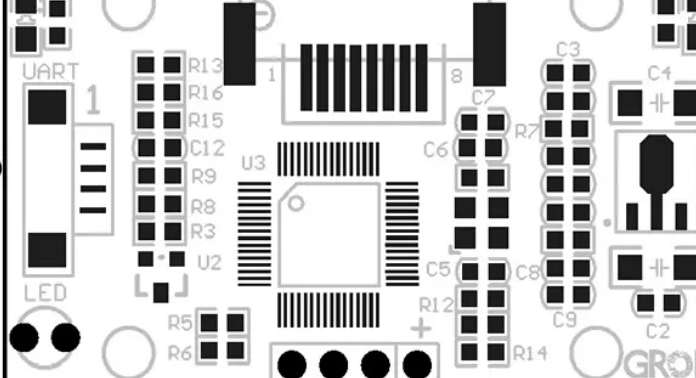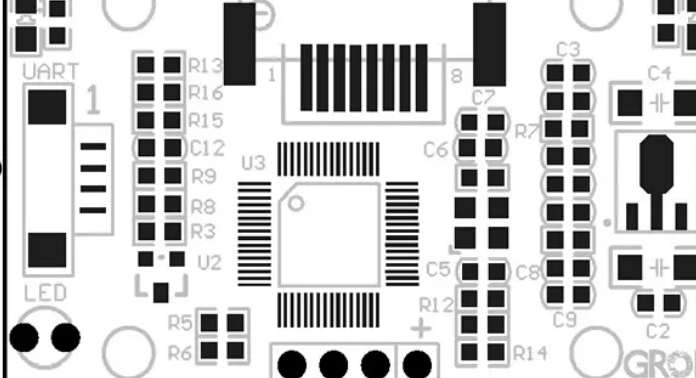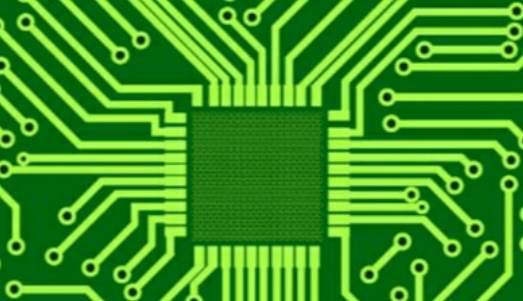
To further illustrate the influence of material thickness on circuit design, another circuit board material was used to perform the same experiment. RO3003 circuit boards from Rogers were selected in three different thicknesses of 5mil, 10mil, and 20mil, with copper foil of the same surface type (½ oz ED copper), and the "Design Dk" values were tested based on differential phase method for 50Ω microstrip transmission lines. In the 50GHz frequency range, the test results show that the "Design Dk" varies with the thickness of the circuit board (as shown in Figure 2).
Using RO3003™ laminate as an example, the effect of material thickness on design Dk values
Effect of copper foil on Dk
All components of the circuit board material affect the "Design Dk", so consider the metrics of all components of the circuit board. For example, the quality of a copper conductor may affect the performance of a circuit at millimeter-wave frequencies. High quality copper conductors can provide transmission lines with high conductivity and high consistent impedance. These characteristics are key factors to ensure that signals maintain phase stability at millimeter wave frequencies, for example, in the application of 77GHz automotive radar.
The surface roughness of copper foil of PCB material will affect the performance of millimeter-wave circuit to some extent. The propagation speed of the electromagnetic wave on the surface of the transmission line fabricated by rough copper foil is slower than that of the transmission line with the same type of copper foil but smoother surface. The so-called copper surface roughness here refers to the roughness of copper on the plane where the substrate contacts the copper foil. A slower electromagnetic wave propagation speed is equivalent to a higher Dk for circuit board materials.
To further illustrate how differences in the surface roughness of copper foils affect the performance of millimeter-wave circuits, a 4mil thick liquid crystal polymer (LCP) is combined with different copper conductors as a dielectric. Copper conductors consist of different types of ED copper, each of which has a different surface roughness. The surface roughness was measured by root mean square (RMS) values of 0.5, 0.7, 1.5 and 3.0μm for the combined copper conductors, respectively.
In order to evaluate the influence of different copper conductors on the material Dk, 50Ω microstrip transmission lines were fabricated on the LCP substrate with four different roughness and tested in the 8 to 50 GHZ frequency band using microwave/millimeter wave vector network analyzer (VNA). The results show that the "effective Dk" values vary depending on the type of copper conductor, but remain nearly constant across the frequency range (see Figure 3).
The effective Dk of the circuit board material varies with the type of copper conductor and the surface roughness
As the measurements show, the same PCB material using different types of copper conductors produces different "effective Dk" values. Circuits with rough copper foil surface materials have higher "effective Dk" values than circuits with smooth copper foil surfaces when the exact same dielectric material is used. Also, you can see that the "slow-wave benefit" of having a more efficient Dk circuit is more significant at higher frequencies.
In addition, the surface roughness of copper foil will also affect the conductor loss, especially at millimeter wave frequency, rough copper conductor surface will lead to higher conductor loss. To verify this conclusion, RO3003 laminates with the same thickness of 5mil were respectively tested with ED copper and calendered copper, where the RMS roughness of ED copper is 2.0μm and that of calendered copper is 0.35μm.

The insertion loss of a 50Ω microstrip transmission line from DC to 110GHz was measured experimentally to compare the loss characteristics of different copper conductors. The effect of (increased) copper surface roughness on conductor loss and insertion loss is obvious (see Figure 4). The thickness of the circuit board material will also affect the loss caused by copper surface roughness. The thinner the material is, the greater the influence of copper foil roughness.
Different types of copper conductors affect the loss performance of the circuit.
How do I keep Dk stable
The on-board radar operating at 77GHz can detect small differences in the phase of the reflected signal. Any change in the circuit board material "Design Dk" will affect the phase state and reduce the detection accuracy of the system. Ideally, you want the Dk value of the circuit board material not to change under any conditions. But the reality is that the "design Dk" of the material will change with frequency, temperature, thickness and other factors. Only when the maximum tolerance of Dk value of intrinsic circuit material is controlled within the range of ±0.05, the phase fluctuation will not affect the high precision and reliability of the system.
In order to monitor the change of circuit board material Dk with temperature, the dielectric constant temperature coefficient (TCDk) is defined as the relative average change rate of the dielectric constant when the temperature increases 1℃ within a certain temperature range. This parameter is important for applications that operate with large temperature differences, such as 77 GHz radars. Any circuit board material used in millimeter-wave circuits should have a low TCDk value to minimize the impact of Dk changes on circuit performance (such as phase shift).
Some PCB materials based on PTFE resin system, at room temperature (25°C) environment, the Dk value will change sharply due to the temperature. For most applications, TCDk within the range of 0±25ppm/°C is considered appropriate. Take RO3003 circuit board as an example. When the temperature changes from -50 to 150°C, the Z-axis TCDk at the 10GHz frequency is only -3 PPM /°C. A smaller TCDk means a smaller Dk with respect to temperature (as shown in Figure 5), which is critical for millimeter wave frequency applications and for circuits that require stable performance over a wide range of temperatures.









